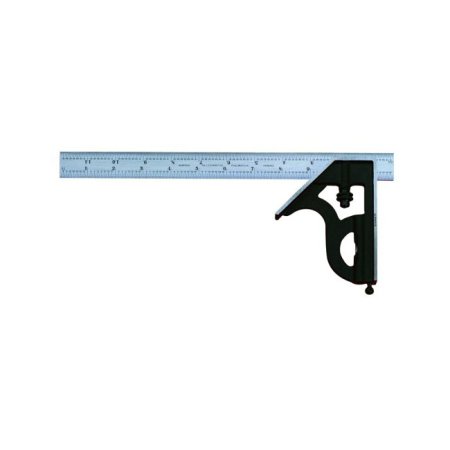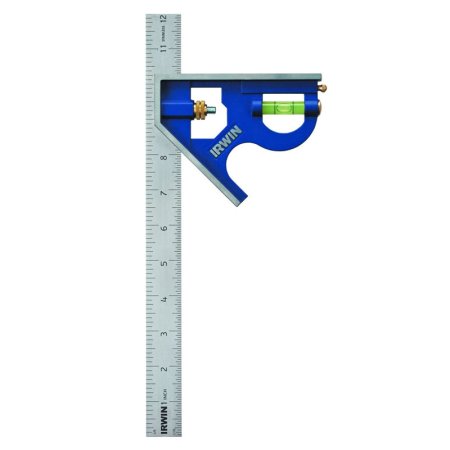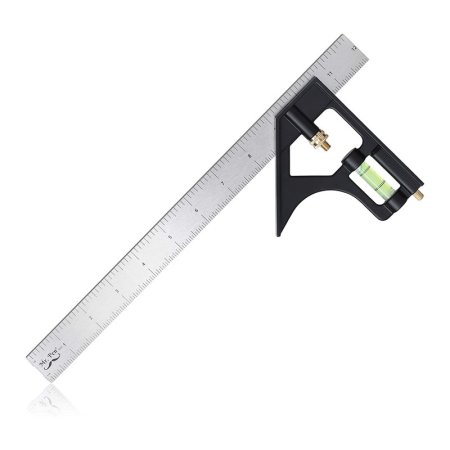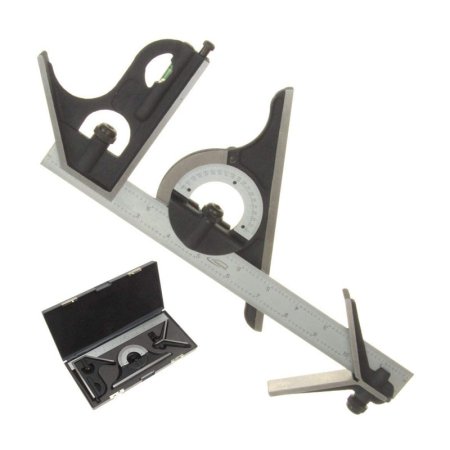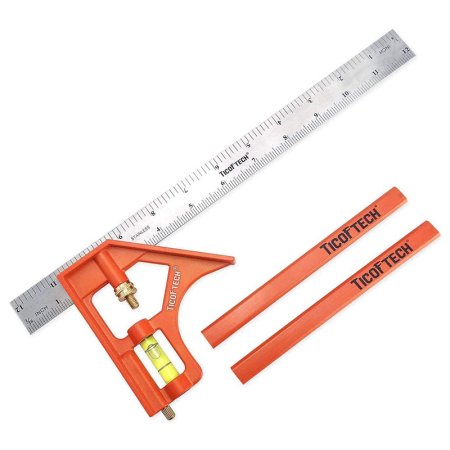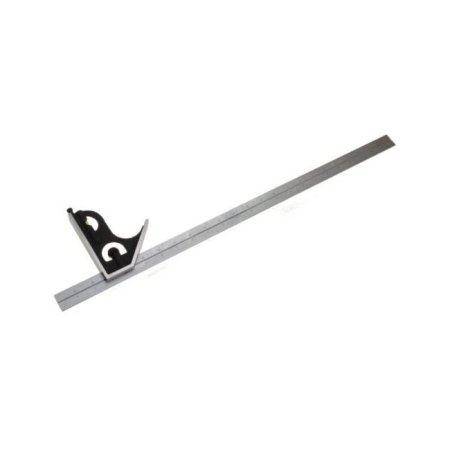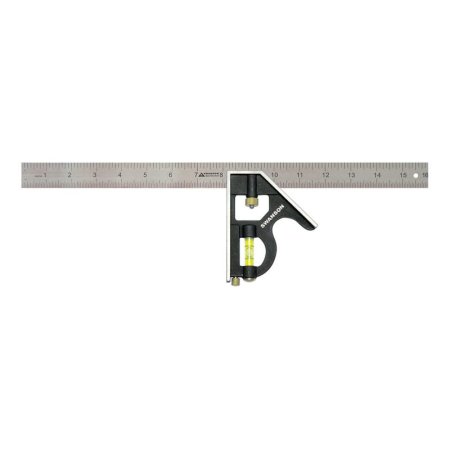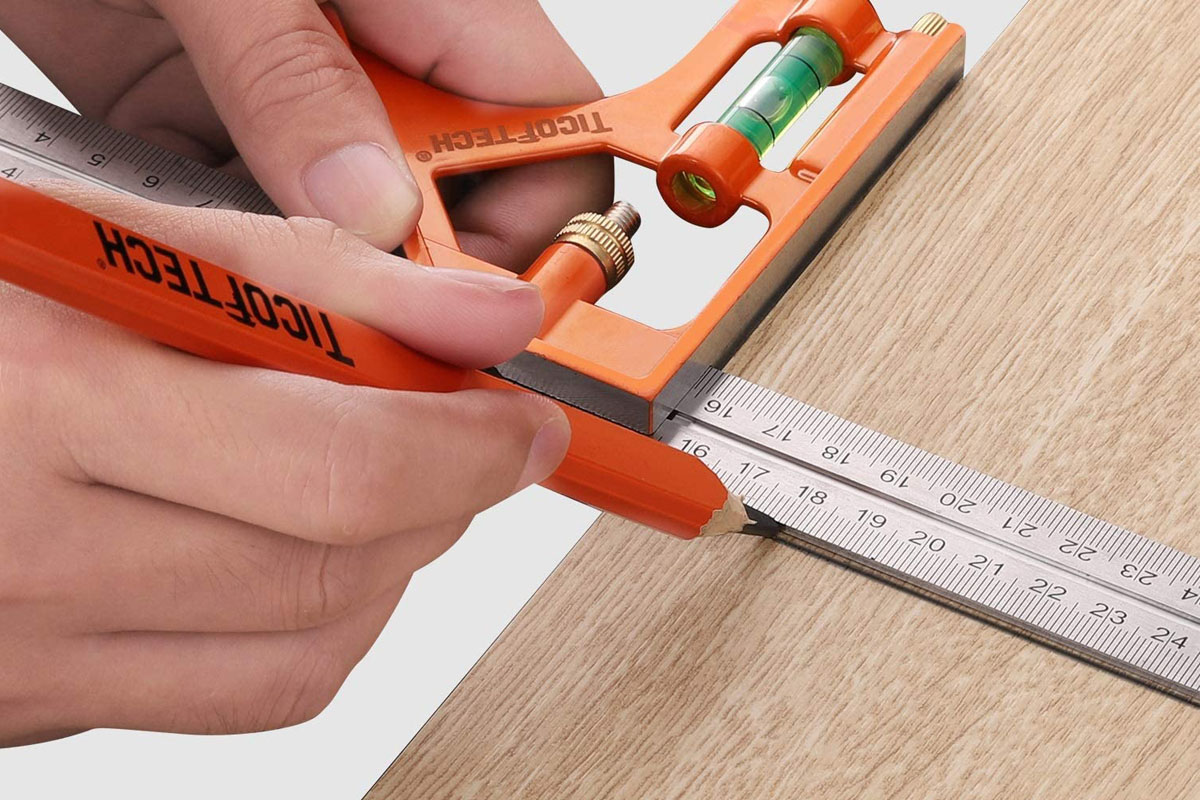
We may earn revenue from the products available on this page and participate in affiliate programs. Learn More ›
Among the wide variety of measuring tools available, a combination square is perhaps the most versatile. It can not only measure length and depth, but also check square and 45-degree angles. Moreover, most squares also include a simple bubble level.
The right combination square can replace several of the tools often considered essential for a woodworking enthusiast. It has a valuable place in the tool kit of DIY fans, remodelers, and contractors.
Numerous models are available, which can make choosing the single best combination square a challenge. The following guide delves into their specifications and should make selecting the right tool easier.
- BEST OVERALL: Starrett-11H-12-4R Combination Square
- RUNNER-UP: Irwin Tools Combination Square, Metal-Body, 12″
- BEST BANG FOR THE BUCK: Mr. Pen- Combination Square, 12″ Combo Square
- BEST COMPACT: IRWIN Tools Combination Square, Metal-Body, 6-Inch
- UPGRADE PICK: iGaging Premium 4-Piece 12″ 4R Combination Square
- BEST MARKING-OUT SET: WORKPRO Rafter Square and Combination Square Tool Set
- BEST DIY: TICOFTECH 12-Inch Combination Square, Inch/Metric
- BEST LARGE LAYOUT: iGaging Combination Square Premium 2-Piece 24″ 4R
- HONORABLE MENTION: Swanson Tool TC134 16-Inch Combo Square
- ALSO CONSIDER: Johnson Level & Tool 12-Inch Metal Combination Square
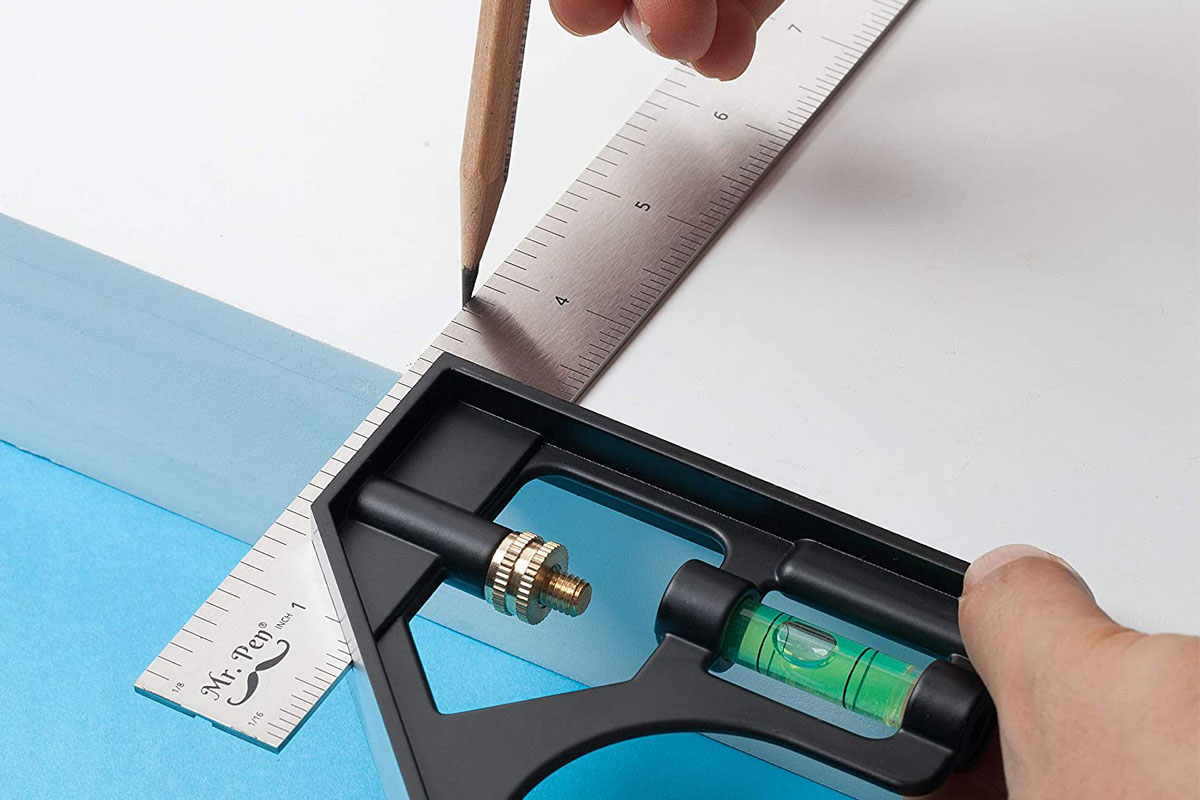
What to Consider When Choosing the Best Combination Square
Combination squares are made from a variety of materials, in different sizes, and various specifications. Some are designed as general-purpose tools, while others are for more detailed engineering tasks. The following guide investigates all the key issues and discusses how to use the tool.
Size and Accuracy
In a combination square, size generally relates to the length of the ruler section, which is called the “blade.” Blades can run from 4 inches on the smallest models to 24 inches on the largest.
While a 4-inch combination square is compact and easy to stow in a tool box, a longer blade is better when checking for square or laying out. A 12-inch combination square, probably the most practical size for general-purpose use, is the most popular. Larger models are available.
Accuracy depends on both the tool’s material and manufacturing technique. Also consider the divisions on the blade. The most detailed is called “4R,” which means it has markings in 1/8-inch, 1/16-inch, 1/32-inch, and 1/64-inch divisions. Lower-cost models may not be as precise. Other models include 10R blades, which are marked in 1/10-inch divisions, metric models, and inch/metric combinations.
The blades are marked in different ways. On low-cost tools, the blade is punched out of sheet metal, with the markings created by the same punch, which often leads to slightly fuzzy markings. Other markings are painted, and they can wear over time to make the scale difficult to read. On better combination squares, the markings are machine etched, resulting in sharper lines, which helps provide greater precision.
Material
Blades are usually made from hardened or stainless steel. The former is very strong but must be cared for properly to avoid rust. To help prevent rust, some combination squares also are chrome plated. Though very durable, stainless steel has slightly less strength and resists corrosion. Blade thickness also can vary considerably. A little flex is unlikely to cause a problem for general carpentry tasks, but it’s undesirable on workpieces that demand high accuracy, such as in engineering applications.
The head can be made of plastic (frequently high-impact polystyrene), die-cast zinc, or cast iron. Plastic heads cost little to produce, reducing the price of the combination square. However, heat might cause distortion, and the bearing surfaces—the 90- or 45-degree areas where the square rests against the workpiece—are easily damaged.
Die-cast zinc is considerably tougher and doesn’t rust, and its bearing surfaces can be accurately machined. It costs more than plastic, so it’s the material of choice for most combination square heads. Cast iron is a premium material reserved for the very best combination units. Although it’s heavy and requires careful maintenance to prevent corrosion, it offers unrivaled durability and can be machined to very fine tolerances.
A steel lock bolt (often with a brass knob) runs in a groove on the back of the blade. It holds the two together while allowing them to slide easily when loosened. A small hardened steel scriber, useful for marking metal, is usually fitted, though a pencil is better for wood. Many squares contain a bubble for checking the level, usually encased in a plastic vial.
Versatility
Use a combination square for a wide range of measuring and marking tasks, both in the workshop or on the job site. The blade can be removed and used as a ruler. Use the bubble level to check alignment when installing doorframes or building partition walls, for example.
Make the square more versatile by using interchangeable heads, which are often included in four-piece combination sets. Along with the blade and standard head, a center finder head makes it easy to find the middle of round or cylindrical objects. A protractor head allows the blade to be set at any angle from 0 to 180 degrees.
Applications
The best quality combination squares feature cast-iron heads with finely ground bearing surfaces and precision-etched blades. Expensive tools, they usually are intended for engineering shops.
At the other end of the scale, many combination squares are ideal for a range of DIY uses. Should they get damaged, replacements are relatively affordable.
In between those extremes, lots of different-size combination squares are designed for remodelers, furniture makers, welders, hobbyists, and more.
Our Top Picks
The following section provides real-world examples across the range of combination squares available. Each was selected for its superior features in its category. The list includes various price, size, and material options.
Best Overall
Starrett-11H-12-4R Combination Square
The Starrett 12-inch combination square is machined and constructed to high standards. The blade is hardened tempered steel, so it’s durable but not brittle. Markings are machine etched into the surface, so they won’t wear off. Graduations use 4R scales. The reversible lock bolt allows the user to switch over the blade without removing the nut.
The head is cast iron with a black, corrosion-resistant finish. The finely ground bearing surfaces help ensure accurate angles. A scriber and bubble level are included.
The Starrett, although a considerable investment, is a precision tool and probably more for engineers than DIY users or contractors.
Runner-Up
Irwin Tools Combination Square, Metal-Body, 12"
Not only is this Irwin 12-inch combination square a popular size, well made, and accurate, but it’s also competitively priced.
The blade is rust-proof stainless steel with clear, sharply etched 4R scales. The die-cast zinc body is corrosion resistant and in Irwin’s trademark blue. The bubble level is unobstructed, so readings are easy to take. A scriber sits alongside it.
Best Bang for the Buck
Mr. Pen- Combination Square, 12" Combo Square
The 12-inch Mr. Pen combination square features a rustproof die-cast zinc head. The blade is stainless steel with clear markings. While divisions go down only to 1/32 inch, it also has a centimeter scale in 1-millimeter (1/10-centimeter) segments. A scriber and bubble level are included.
The blade is a little thin, as is the head casting, so it may not be as durable as a higher quality tool. However, the price is so low a replacement is quite affordable.
Best Compact
IRWIN Tools Combination Square, Metal-Body, 6-Inch
To make measurements or check angles in a confined space, the 6-inch Irwin combination square offers a solution. The blade is rigid, rust-resistant stainless steel with easy-to-read markings etched into the surface. The divisions are only in 1/8-inch and 1/16-inch segments, but the reverse side of the blade has a metric scale in 1-millimeter divisions.
The head is a die-cast zinc unit that fits comfortably in the hand and offers a bubble level and a scriber.
Upgrade Pick
iGaging Premium 4-Piece 12" 4R Combination Square
A 12-inch stainless steel blade with machine-etched 1/8-inch, 1/16-inch, 1/32-inch, and 1/64-inch 4R divisions are at the center of the four-piece iGaging combination square. Fine markings like these usually indicate a precision tool.
The package includes three die-cast zinc heads, including a standard head with the typical bubble and scriber; a centering head with 90-degree jaws to rest on the edge of a round or cylindrical workpiece; and, finally, a protractor head, which adjusts to 180 degrees and is reversible. It comes in a well-organized case.
Best Marking-Out Set
WORKPRO Rafter Square and Combination Square Tool Set
The WORKPRO combination square features a stainless steel blade that offers etch-marked 1/32-inch and 1-millimeter divisions. The head is sturdy die-cast zinc with a bubble level and scriber included.
The combination square is very versatile, but for fast marking out, many professional carpenters use a rafter square (also called a “speed” square). This tool contains a host of common spacings and angles precut into it, with slots designed for a carpenter’s pencil to fit into each.
The WORKPRO rafter square is 13/64-inch-thick aluminum. The 7/8-inch fence also can be used as a circular saw guide when crosscutting lumber.
Best DIY
TICOFTECH 12-Inch Combination Square, Inch/Metric
While the 4R marking system is popular on precision combination tools, many DIY users don’t need the ability to measure and mark to 1/64-inch accuracy.
With scales of 1/8 inch and 1/16 inch on one side and 1 millimeter on the other, the easy-to-read TICOFTECH blade is adequate for most home woodworkers or DIYers. It’s made of hardened steel, which is more durable than chrome-finished steel. The head is die-cast zinc with the usual bubble and scriber.
A scriber can make clear marks on sheet metal, but not on wood. The sharp point seems to dig into the wood grain, and it’s quite difficult to create a clear, straight line. Instead, woodworkers generally use a pencil, so the TICOFTECH package includes two carpenter’s pencils.
Best Large Layout
iGaging Combination Square Premium 2-Piece 24" 4R
The manufacturing standards that iGaging employs when making their 24-inch combination square helps provide accurate measuring and marking of larger projects.
The blade, made of corrosion-resistant stainless steel, uses the 4R marking system, laser etched to allow for the close tolerances necessary for accurate measurements. The thick die-cast zinc head provides substantial support, and it includes a bubble level and scriber.
The package includes a protective case with slots for centering. DIYers can buy protractor heads with the tool.
Honorable Mention
Swanson Tool TC134 16-Inch Combo Square
This rustproof stainless steel blade offers clear etched divisions at 1/8 inch, 1/16 inch, and 1/32 inch. It includes a metric scale in 1-millimeter increments.
The head is die-cast zinc, which has been CNC machined to create markings on 45- and 90-degree surfaces. The retaining nut for the blade is sprung, so it prevents the blade from falling out even when loosened. The bubble level is made of impact-resistant acrylic, and it includes a scriber.
Also Consider
Johnson Level & Tool 12-Inch Metal Combination Square
The 12-inch combination square from Johnson Level & Tool is designed for basic marking and measuring. It’s aimed at occasional DIY users and hectic job site environments in which rough wear and tear on the tool is inevitable.
The blade is stainless steel, so it won’t rust, but the graduations are punched rather than etched. Markings are in 1/8-inch, 1/16-inch, and 1/32-inch divisions with a 1-millimeter metric scale as well. The head is die-cast zinc with a chip-resistant finish. An acrylic vial protects the bubble, and a scriber is included.
FAQs About Combination Squares
This guide provides a comprehensive description of the key features in the best combination squares. However, given the variety of tools available and the various uses for them, a number of questions may remain. The following answers address those frequently asked questions.
Q. How do I use a combination square?
The versatility offered by a combination square is one of its main attractions. You can use the ruler to check length or the handle as a base for checking height or depth recesses. Use the “square” portion to mark or check 45- and 90-degree angles, and the bubble, if included, checks level.
Q. How do I maintain a combination square?
As with any tool, dirt is the main problem. Periodically disassemble and clean the components with a nonabrasive scourer and a little spirit or rubbing alcohol to remove deposits. After it dries, give the blade slide a light wipe with paste wax to lubricate it.
Q. How accurate are combination squares?
Accuracy depends on the model and its age. Many are manufactured to tolerances of 0.001 inch; however, friction can eventually impact the screw threads and guideways, which become looser over time. Quality tools will last many years, but budget models must be replaced more frequently.
Q. How do I know if a combination square is accurate?
To test the square’s accuracy, use a piece of board with a flat, machined edge, such as plywood or MDF. With the head set at one end of the ruler, place the tool against the edge of the board as if checking for square. With a sharp pencil, draw a line along the blade. Flip the combination square over, so the head creates a mirror image. Place the base at the bottom of the first line and draw a second line along the blade. The two lines should be parallel. If they form a shallow “V,” the square is not accurate and should be calibrated.
Q. How do I set or calibrate a combination square?
Loosen and remove the blade. Check that the groove in which the blade runs is clean; even a tiny particle of dirt can force the blade out of square. Reassemble and check it again following the procedure in the previous answer. If it still doesn’t align properly, adjust the blade groove with fine metal sandpaper wrapped around the blade itself or a fine needle file. Think carefully about which side to work on to correct the angle. Work slowly and check it frequently until the issue is resolved.



